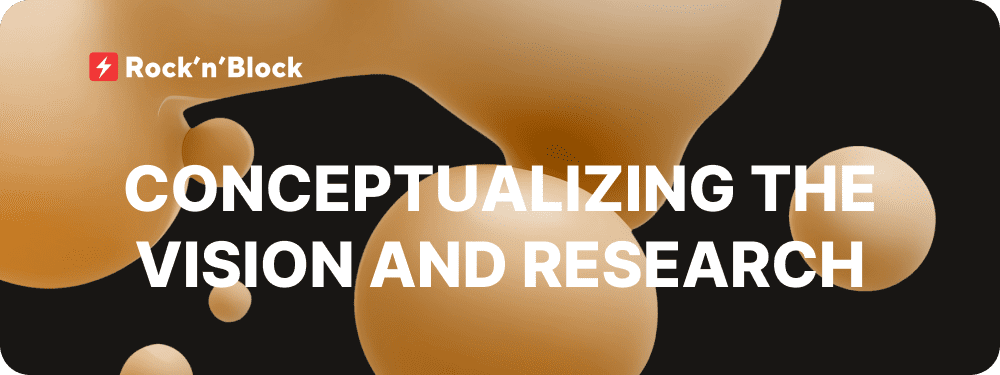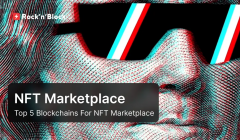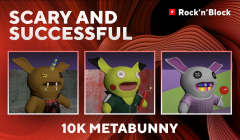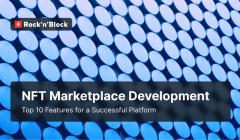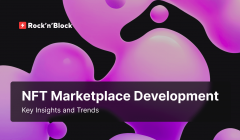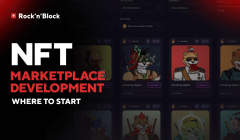NFT Marketplace Development: 5 Key Stages
03 May 2024In the constantly evolving world of blockchain technology, Non-Fungible Tokens (NFTs) have become a significant game-changer, altering how we perceive and trade digital assets. NFT marketplaces have become the epicenter of a digital renaissance. Today we will explore the fundamental components that form the blueprint for NFT marketplace development growth, unlocking the key to prosperity in this dynamic arena.
In this article, we present the essential stages and factors necessary for a flourishing entry into the NFT marketplace development industry. We cover everything from formulating the initial concept to implementing the intricate technicalities of blockchain integration, smart contract development, and user interface design. We explore the key components that influence these digital marketplaces.
Join us on a comprehensive exploration of NFT marketplace development, where we offer insightful strategies and a roadmap to empower creators, entrepreneurs and enthusiasts in this exciting, ever-changing realm.

Table of Contents:
-
The Core of NFT Marketplace Development
-
NFT Marketplace Development Main Stages
-
For Whom It Is Best
-
Conclusion
The Core of NFT Marketplace Development
An NFT marketplace is a digital platform where unique digital assets are purchased, sold, and exchanged using blockchain technology. The technical essence of NFT marketplace development lies in the use of blockchain technology and smart contracts to ease the creation, ownership proof, and transfer of Non-Fungible Tokens (NFTs).
At its core, an NFT compiles a distinctive digital asset represented by a tokenized certificate of ownership, stored on a blockchain. Smart contracts, which are self-executing code, govern the rules and functionalities of these tokens, ensuring their scarcity, indivisibility and traceability.
Blockchain Selection and Smart Contracts
The technical architecture involves integrating secure wallet solutions for users to store and transact their NFTs. Blockchain, a decentralized and distributed ledger, serves as the foundation for recording and verifying ownership of Non-Fungible Tokens.
The selection of a blockchain is critical, with Ethereum being a favored option, but alternative blockchains such as Binance Smart Chain and others are becoming more popular due to scalability issues. The integration of wallets guarantees the secure storage and transfer of NFTs, while deliberations regarding scalability and low transaction costs enhance the marketplace's overall efficiency.
In essence, the key elements of NFT marketplace development must be synchronized to establish a resilient, dependable, and accessible system for the successful trading of exclusive digital assets.
The decentralized and immutable nature of blockchain technology development guarantees the legitimacy and origin of digital assets, establishing a secure and translucent atmosphere for artists and buyers alike operating within the NFT marketplace.
NFT Marketplace Development Main Stages
In this part, we embark on a comprehensive exploration of the key stages in NFT marketplace development. From conceptualizing the vision to the intricacies of smart contract development, user-friendly interface design, and the nuances of post-launch support, we delve into the technical and strategic considerations that shape the trajectory of these digital marketplaces.
Be sure to check out our detailed step-by-step guide: NFT Marketplace Development from Scratch.
1. Conceptualizing the Vision and Research
Understanding your niche
The process of establishing an NFT marketplace commences with a definite and strong vision. Irrespective of whether you concentrate on digital art, tokenizing real-world assets, music or other specific digital assets, a clear understanding of your niche will guide decision-making throughout the NFT marketplace development process.
This requires identifying the intended audience, evaluating market patterns, and discriminating the exceptional requirements and preferences of the creators and collectors within that particular domain. Tailoring the platform to meet the particular demands of your chosen niche not only improves user experience but also fosters a sense of community. This understanding serves as the compass, guiding the NFT marketplace development team in creating features for NFT marketplace, designing interfaces, and implementing functionalities that resonate with the niche audience, fostering a more engaging and successful NFT marketplace.
Research
The initial stage in NFT marketplace development is critical to its success, as it sets the foundation for the entire project. The research phase comprises a comprehensive analysis of various key elements. Primarily, it is essential to understand the target audience and determine the specific niche or category for the NFT marketplace development.
In-depth exploration of blockchain technology is necessary to select the most appropriate platform, taking into account scalability, security, and transaction costs.
Smart contracts development requires thorough research to ensure the code controlling NFT creation and transactions is secure. It is also important to analyze competitors and market trends to identify opportunities and differentiate the platform.
Examining user experience and interface design helps create an intuitive platform, while understanding the regulatory landscape is critical for compliance.
This thorough research stage is crucial for reducing risks, aligning NFT marketplace development with market requirements, and ultimately supporting the success of the marketplace through the creation of a strong foundation for informed decision-making throughout the development cycle.
2. The Building Stage
The building phase of NFT marketplace development represents the practical implementation of the findings from the research phase. This phase primarily involves coding and constructing the NFT marketplace, bringing the envisioned features and functionalities to life.

It is during this phase that theoretical concepts take on a concrete form, requiring a collaborative effort between NFT developers, designers and other stakeholders. The significance lies in converting a concept into a practical solution, forming the NFT marketplace into an easy-to-use, safe, and pioneering platform that conforms to market requirements and regulatory norms.
There are certain features that are indispensable for the successful NFT platform development. Our comprehensive article outlines these key elements in detail.
Choosing the Right Blockchain
Selecting the appropriate blockchain is a crucial aspect of NFT marketplace development as it affects the platform's scalability, security, and functionality. This requires a comprehensive assessment, considering many elements.
Initially, developers must evaluate the blockchain's scalability to ensure it can manage the expanding transaction volume as the marketplace expands. Robust protocols are essential for security, ensuring that the blockchain effectively safeguards both digital assets and user information.
To create a cost-effective and user-friendly environment, it is necessary to analyze transaction costs, particularly gas fees. The blockchain's consensus mechanism plays a crucial role in decentralization and trustworthiness. It is also important for the development team to assess the level of support and developer activity within the community surrounding the chosen blockchain.
However, due to scalability problems, alternative blockchains like Binance Smart Chain, Flow, and Polygon are gaining popularity. Ethereum has been the chosen option so far. Each blockchain has its distinct characteristics, so it is vital to match your project's needs with the appointed blockchain's capabilities.
To further dive into the blockchain selection process for NFT marketplace development, we recommend exploring our guide: top 5 blockchains for NFT marketplace development in our recent post.
This process is of utmost importance since the blockchain supports NFT creation, transfer, and ownership. Making well-informed decisions is vital to ensure the long-term viability of the NFT marketplace development, creating a secure and efficient environment for both creators and collectors.
Smart Contract Development
Smart contract development is essential in NFT marketplace development as it serves as the foundation that governs the creation, ownership, and transfer of non-fungible tokens. The process requires developers to code smart contracts accurately to ensure transparency, security, and trust within the ecosystem. Consistency in the application of metrics and units within the smart contracts is also crucial. They must define the rules for creating tokens, establish ownership protocols, and include features such as royalties for creators on secondary sales.
Smart contract development is crucial in automating and enforcing the terms of NFT transactions. This ensures the authenticity and uniqueness of digital assets and contributes to the decentralized and trustless nature of blockchain technology. A well-crafted smart contract is essential for building user confidence, enabling seamless interactions, and establishing a foundation for a sustainable and fair NFT marketplace development ecosystem.
User-Friendly Interface
Creating a user-friendly interface in NFT marketplace development entails intuitive navigation, simplified onboarding, seamless wallet integration, visually appealing designs, responsive layouts, transparent pricing, robust search and filtering options, social features, and feedback mechanisms.
The interface should guide users effortlessly through account creation, wallet connection, and NFT transactions while presenting information in a clear, organized manner.
Visual appeal and responsive design ensure a consistent experience across devices, while features like search filters and social engagement enhance user satisfaction and community interaction.
Transparent pricing and feedback mechanisms build trust, fostering a positive user experience essential for the success of the marketplace.
Wallet Integration and Security
The integration of secure digital wallets into an NFT marketplace is a crucial step for the NFT marketplace development, where the seamless execution of transactions meets the imperative need to secure digital assets.
The wallet integration includes the incorporation of secure digital wallets into the platform, offering users the ability to store, manage, and perform NFT transactions. This process requires compatibility with different wallet providers and blockchain networks, ensuring flexibility for users.
Security measures encompass encryption protocols, multi-factor authentication, and other robust mechanisms to safeguard user accounts and sensitive information. It's crucial to integrate secure wallet features to instill user trust and confidence in the platform. Users require assurance that their digital assets are protected, and transactions are conducted in a secure environment.
By prioritizing wallet integration and ensuring strong security measures, NFT marketplaces not only offer a seamless user experience but also establish a foundation of trust, supporting a thriving ecosystem for both creators and collectors.
Gas Fees and Scalability
An NFT marketplace development requires a critical consideration of the gas fees and scalability issues, which significantly affect the platform's efficiency and user experience. The gas fees refer to the transaction costs associated with blockchain networks, which can reduce the affordability of NFT transactions. To mitigate high gas fees, developers often explore alternative blockchains, layer-2 solutions, or implement gas optimization strategies.
Scalability is a critical aspect of NFT marketplace development, ensuring the platform can handle increasing user demand, transaction volumes, and growing NFT collections without sacrificing performance or user experience. Scalability also encompasses considerations for user onboarding, wallet integration, search functionality, and overall platform responsiveness to accommodate a larger user base and diverse NFT offerings. By prioritizing scalability in NFT marketplace development, developers can ensure the platform can scale efficiently to meet the needs of a rapidly expanding market while delivering a seamless and reliable experience for users and creators alike.
3. Test and Launch

The testing and launching phase in NFT marketplace development is crucial to ensuring the platform's reliability, functionality, and security before it's made public. This stage entails comprehensive testing of each component, such as smart contracts development, user interfaces, wallet integrations, and security features.
NFT developers conduct detailed quality assurance tests to identify and rectify possible bugs, vulnerabilities, or performance issues. The significance of this process lies in its capability to proactively resolve potential issues that may affect the user experience or the security of digital assets.
Following the successful completion of the testing phase, the NFT marketplace is prepared for launch. Launch planning typically entails marketing activities to raise awareness, attract creators and collectors, and foster a vibrant community. A well-executed testing and launch process not only guarantees a smooth and secure platform but also enhances the market's credibility and potential for success in the competitive NFT trading landscape.
4. Marketing & Growth

The marketing and growth process is essential to the post-launch success of an NFT marketplace development, serving as the engine that propels the platform into the digital spotlight. Marketing activities create brand awareness, attract creators, and entice collectors to participate in the marketplace.
To build a thriving ecosystem, strategic promotional campaigns, collaborations with artists and influencers, and community engagement are of utmost importance. Moreover, growth strategies encompass broadening the user base, augmenting transaction volumes, and monitoring emerging market trends.
The significance of efficient marketing and growth cannot be overstated in an intensely competitive marketplace, as they contribute to the continuous visibility, dependability, and vigor of the NFT market. By refining marketing strategies, nurturing community relationships, and adapting to the changing needs of users, the market can establish a robust presence in the ever-evolving digital asset trading landscape, leading to long-term success.
Community Engagement
The building of a thriving and interconnected ecosystem is heavily dependent on the community engagement process within the NFT marketplace development. Besides the technical aspects, it is fundamentally essential to construct a vibrant community for the continuous success of the platform.
The process requires active participation with users, creators, and collectors through various platforms such as social media, forums, and events. Involving the community creates a sense of belonging and generates valuable feedback that aids in refining and evolving the platform. Contests, collaborations, and special events organized by the community enhance the collective excitement and loyalty towards the NFT marketplace. Establishing clear communication and actively engaging with the community in decision-making creates trust and strengthens the platform's position within the digital community. The community engagement process builds a vibrant and supportive network that forms a crucial part of the NFT marketplace's identity and success, going beyond attracting users.
Marketing and Partnerships
Marketing and partnerships are vital for the success of NFT software development. Effective marketing involves building brand awareness, targeted advertising, community engagement, and content marketing. Strategic partnerships with NFT marketplaces, blockchain projects, artists, and influencers can expand reach and credibility. By implementing these strategies, developers can increase visibility, drive adoption, and establish a strong presence in the competitive NFT ecosystem.
5. Post-Launch Support

Post-launch support is essential in running a successful NFT marketplace. Consistent support after the launch ensures stability, tackles emerging challenges and enhances user satisfaction. This involves addressing technical issues quickly, providing responsive customer support, and making updates or enhancements based on user feedback. Post-launch support involves adapting to changing market trends, expanding infrastructure to cater to an increasing user base, and keeping up to date with developments in blockchain technology. Through consistent monitoring and optimization of the platform, post-launch support not only maintains the marketplace's functionality but also enhances its longevity and competitiveness in the constantly evolving digital asset trading landscape.
For Whom It Is Best
Creating your own NFT marketplace is especially attractive to artists and content creators who desire increased control over the distribution and monetisation of their digital assets. Additionally, entrepreneurs with expertise in the NFT industry and a vision for a specialized market can benefit from the creative and financial prospects provided by an independent platform.
Advantages
1. Tailored User Experience: Creating your own marketplace offers the opportunity to craft a distinctive and customized user experience based on your vision and the needs of your target audience.
2. Reduced fees: Compared to established marketplaces, operating your platform allows you to establish reduced transaction fees, thereby ensuring that a greater proportion of proceeds are directed towards creators.
3. Community Building: Independent platforms cultivate a sense of community, enabling artists and collectors to interact directly, exchange ideas, and forge connections, thereby building a committed user base.
4. Creative Control: The platform owners enjoy the liberty to establish regulations, devise functionalities, and curate materials, preserving creative independence over the platform's trajectory.
Risks
1. Technical Complexity: Developing and maintaining an NFT marketplace can be technically complex, requiring significant expertise in areas such as blockchain integration and smart contract development.
2. User Acquisition: Attracting and retaining users in a competitive market is a significant challenge. Established platforms benefit from network effects that new entrants may find difficult to overcome.
3. Regulatory Uncertainties: There are regulatory uncertainties to contend with due to the evolving regulations concerning cryptocurrencies and NFTs, which could impose legal risks on independent platforms.
4. Financial Investment: Building and sustaining an NFT marketplace requires a financial commitment, including development costs, marketing expenses, and ongoing operational investments.
Conclusion
As we stand on the edge of a digital revolution, the NFT marketplace development blueprint serves as a guide for those brave enough to venture into this transformative space. By combining strong vision, technological prowess and community engagement, developers can create platforms that not only facilitate the exchange of digital assets, but also contribute to the cultural shift towards decentralized and democratized creativity. The framework is established; it is now up to you to paint your canvas with the colors of innovation and success in the world of NFTs. And we are always ready to help you develop your own blockchain solution.
We ❤️ Development
Follow us on social media to receive the hottest blockchain development updates
Crunchbase ⚡️ Twitter ⚡️ Telegram ⚡️ LinkedIn ⚡️ Facebook ⚡️ Zupyak ⚡️ Quora ⚡️ Reddit

